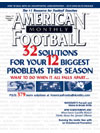AMERICAN FOOTBALL MONTHLY THE #1 RESOURCE FOR FOOTBALL COACHES
Article CategoriesAFM Magazine
|
- More Solutions to Problem #6© More from this issueContinued from: 32 Solutions for the 12 Biggest Problems You'll Face this Season Problem 6: Tackling issues – the team’s consistency in missing tackles..how do you improve this problem? We go back to the basics as a team to reinforce the proper fundamentals of tackling. In defensive individual time we also spend a lot of time on various tackling drills. Keith Wheeler, Offensive Coordinator/QB Coach Holbrook Roadrunners (AZ) The solution: my experience is to return to fundamentals after reviewing tape/video and meeting with all defensive coaches regarding tackling. Tackling is DESIRE equipped with technique. Many components are in tackling, so prop....The full article can only be seen by subscribers. Subscribe today!
|
|
|||||||
| HOME |
MAGAZINE |
SUBSCRIBE | ONLINE COLUMNISTS | COACHING VIDEOS |
Copyright 2025, AmericanFootballMonthly.com
All Rights Reserved





